[1]
A. Asikainen, A. Ala-Fossi, A. Visala, P. Pulkkinen, Forest Technology Vision and Roadmap for 2020, Working Papers of the Finnish Forest Research Institute 8(2005) 1-92.
Google Scholar
[2]
Y. Gerasimov, A. Seliverstov, Industrial Round-wood Losses Associated with the Harvesting Systems in Russia, Croat. J. For. Eng. 31(2010) 111-126.
Google Scholar
[3]
Y. Gerasimov, V. Senkin, K. Väätäinen, Productivity of Harvesters in Clear Cuttings, Resources and Technology 9(2012) 82-93.
DOI: 10.15393/j2.art.2012.1642
Google Scholar
[4]
A. Sokolov, A. Seliverstov, Y. Gerasimov, Ergonomic Evaluation of Wood Harvesting Machines, Resources and Technology 9(2012) 106-116.
DOI: 10.15393/j2.art.2012.1644
Google Scholar
[5]
Y. Gerasimov, A. Sokolov, Ergonomic Characterization of Harvesting Work in Karelia, Croat. J. For. Eng. 30(2009) 159-170.
Google Scholar
[6]
V. Katarov, V. Syunev, E. Ratkova, Y. Gerasimov, Impact of Wood Forwarding on Forest Soils, Resources and Technology 9(2012) 73-81.
DOI: 10.15393/j2.art.2012.1641
Google Scholar
[7]
Y. Gerasimov, V. Katarov, Effect of Bogie Track and Slash Reinforcement on Sinkage and Soil Compaction in Soft Terrains, Croat. J. For. Eng. 31(2010) 35-45.
Google Scholar
[8]
Y. Gerasimov, A. Seliverstov, V. Syunev, Industrial Round-Wood Damage and Operational Efficiency Losses Associated with the Maintenance of a Single-Grip Harvester Head Model: A Case Study in Russia, Forests 3(2012) 864-880.
DOI: 10.3390/f3040864
Google Scholar
[9]
Y. Gerasimov, V. Senkin, K. Väätäinen, Productivity of Single-grip Harvesters in Clear-cutting Operations in the Northern European Part of Russia. Eur. J. For. Res. 131(2012) 647-654.
DOI: 10.1007/s10342-011-0538-9
Google Scholar
[10]
A. Seliverstov, A. Sokolov, V. Syunev, Y. Gerasimov, Impact of Wood Harvesting Systems on Round Wood Quality, Resources and Technology 9(2012) 94-105.
DOI: 10.15393/j2.art.2012.1643
Google Scholar
[11]
A. Sokolov, V. Syunev, Y. Gerasimov, T. Karjalainen, Optimisation of Wood Logistics, Resources and Technology 9(2012) 116-127.
DOI: 10.15393/j2.art.2012.1648
Google Scholar
[12]
Y. Gerasimov, T. Karjalainen, Development Program for Improving Wood Procurement in Northwest Russia Based on SWOT Analysis, Baltic Forestry 14(2008) 85-90.
Google Scholar
[13]
T. Nordfjell, R. Bjorheden, M. Thor, I. Wasterlund, Changes in Technical Performance, Mechanical Availability and Prices of Machines Used in Forest Operations in Sweden from 1985 to 2010, Scand. J. For. Res. 25(2010) 382–389.
DOI: 10.1080/02827581.2010.498385
Google Scholar
[14]
Metla, Finnish Statistical Yearbook of Forestry, Finnish Forest Research Institute, Helsinki, 2012.
Google Scholar
[15]
Y. Gerasimov, A. T. Karjalainen, Estimation of Machinery Market Size for Industrial and Energy Wood Harvesting in the Leningrad Region, Croat. J. For. Eng. 33(2012) 49-60.
Google Scholar
[16]
E. Streltsov, Import Logging Equipment to Russia, Basic Funds 2(2011) 80-82.
Google Scholar
[17]
Information on http://www.ponsse.fi
Google Scholar
[18]
V. Goltsev, J. Ilavsky, Y. Gerasimov, T. Karjalainen, Potential for Biofuel Development in Tihvin and Boksitogorsk Districts of the Leningrad Region, Forest Policy Econ. 12(2010): 308-316.
DOI: 10.1016/j.forpol.2009.10.007
Google Scholar
[19]
Y. Gerasimov, T. Karjalainen, Energy Wood Resources in Northwest Russia, Biomass and Bioenergy 35 (2011) 1655-1662.
DOI: 10.1016/j.biombioe.2010.12.039
Google Scholar
[20]
V.A. Shlyamin, Russian-Finnish Partnership in Forest Machine Production, Publishing- Polygraphic Association of Universities of Russia, Saint-Petersburg, 2012.
Google Scholar
[21]
J. Uusitalo, Introduction to Forest Operations and Technology, JVP Forest Systems Oy, Tampere, 2010.
Google Scholar
[22]
I.R. Shegelman, V.I. Skrypnik, O.V. Galaktionov, Innovation Logging Technology, Petrozavodsk State University Press, Petrozavodsk, 2012.
Google Scholar


